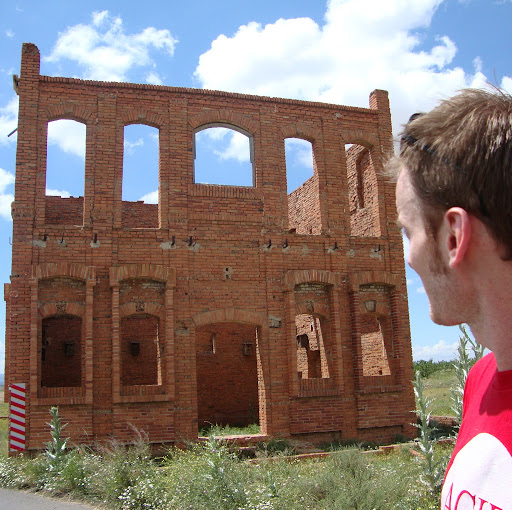Brian E Calvert
age ~60
from Dripping Springs, TX
- Also known as:
-
- Brian Edward Calvert
- Briane Calvert
Brian Calvert Phones & Addresses
- Dripping Springs, TX
- Scottsdale, AZ
- 2917 Etna Dr, Austin, TX 78738 • (512)4021402
- 8100 Doe Meadow Dr, Austin, TX 78749 • (512)2885659
- Naperville, IL
- Itasca, IL
- Hays, TX
- Dripping Spgs, TX
Us Patents
-
Method For Informing A User Of A Communication Device Where To Obtain A Product And Communication System Employing Same
view source -
US Patent:6526275, Feb 25, 2003
-
Filed:Apr 24, 2000
-
Appl. No.:09/556385
-
Inventors:Brian Edward Calvert - Austin TX
-
Assignee:Motorola, Inc. - Schaumburg IL
-
International Classification:H04M 300
-
US Classification:455418, 455456, 455566, 455435
-
Abstract:A communication system ( ) employs a method for informing a user of a communication device (e. g. , ) where to obtain a product. The communication system determines an approximate location of the communication device and whether a particular requested product or one or more other potentially desirable products are available in a general vicinity of the device. When the particular or potentially desirable product is so available, a context engine server ( ) of the communication system conveys a product information request and optionally other purchaser-related information to multiple product providers ( ). The context engine server receives responses to the product information request from at least some of the product providers, wherein at least some of the responses preferably include offers to pay respective advertising fees. The context engine server generates a list of product providers based on the responses and provides the list to the communication device for display to the device user.
-
Method And Apparatus For Accurately Locating A Communication Device In A Wireless Communication System
view source -
US Patent:20020102989, Aug 1, 2002
-
Filed:Jan 26, 2001
-
Appl. No.:09/769939
-
Inventors:Brian Calvert - Austin TX, US
Jason Mann - Georgetown TX, US
Jheroen Dorenbosch - Paradise TX, US -
International Classification:H04Q007/20
-
US Classification:455/456000, 455/414000, 455/457000
-
Abstract:A wireless communication system employs a method and apparatus for accurately locating a communication device in the system. The communication system includes a system infrastructure that provides communication services to communication devices distributed throughout the communication system. Either on its own or, more preferably, responsive to a request from a requesting device for an accurate location of a particular communication device, the system infrastructure determines an approximate geographic location of the communication device. Based on the approximate location, the infrastructure transmits a request to the communication device for a more accurate location of the device preferably together with a map of an area that includes the approximate location of the device. The communication device preferably displays at least the map to a user of the device and, responsive to user input, transmits the more accurate location of the device to the system infrastructure. After receiving the more accurate location, the system infrastructure conveys the location to a target device preferably identified in the original location request received by the infrastructure.
-
Data Processor Initialization Program And Method Therefor
view source -
US Patent:56131194, Mar 18, 1997
-
Filed:Jul 25, 1994
-
Appl. No.:8/279602
-
Inventors:Robert B. France - Austin TX
Arthur H. Claus - Austin TX
Brian E. Calvert - Austin TX -
Assignee:Motorola Inc. - Schaumburg IL
-
International Classification:G06F 944
-
US Classification:395651
-
Abstract:A program (818) utilizes a functional description of a data processor to verify that the operations requested by the user are valid in the current context of the development environment (10). The program performs each of these functions by checking both physical (820) and contextual rules (838) stored in a memory (9). The program ensures that registers and memory in the data processor cannot be illegally configured and, therefore, fewer programming errors will occur during the development stages of a new data processing system.
-
Interactive Memory Organization System And Method Therefor
view source -
US Patent:56236646, Apr 22, 1997
-
Filed:Jul 25, 1994
-
Appl. No.:8/279605
-
Inventors:Brian E. Calvert - Austin TX
Arthur H. Claus - Austin TX
Robert B. France - Austin TX -
Assignee:Motorola, Inc. - Schaumburg IL
-
International Classification:G06F 944
-
US Classification:395651
-
Abstract:A method, referred to as the interactive memory mapper or IMM (322), allows a user to program a memory (9) of a data processor (14) using a computer terminal (12) as a visual interface. The IMM allows a user to view and modify a pictorial representation of a data processor's memory space. When the IMM is utilized to allow the plurality of memory blocks to be viewed on the computer terminal, each block has visible attributes corresponding to the memory located at a memory address. Each of the plurality of memory blocks may be selected using a pointing device or keyboard and the blocks' attributes may be modified via an auxiliary controls subroutine (90) of the IMM program. The selected blocks may be created, moved, and resized to either add or subtract additional memory space, but is constrained to legal configurations determined by the specification of the data processor.
-
Combining Network Analysis And Predictive Analytics
view source -
US Patent:20160127195, May 5, 2016
-
Filed:Nov 5, 2014
-
Appl. No.:14/533968
-
Inventors:- San Jose CA, US
Brian E. Calvert - Dripping Springs TX, US
Michael Betron - Austin TX, US -
International Classification:H04L 12/24
G06F 7/36
H04L 29/08 -
Abstract:Records are obtained from sources and typed datasets are assembled based on the obtained records. Relationships are identified among the typed datasets and at least one network comprising nodes and edges are assembled based on the identified relationships. A network analyzer assembles a vector and the vector is passed to analytics. The analytics then generate an output that is provided to a user or other device in the form of data.
Medicine Doctors

Brian D. Calvert
view sourceSpecialties:
Optometry
Work:
Brian D Calvert OD
3429 Renner Dr, Fortuna, CA 95540
(707)7255255 (phone), (707)7258833 (fax)
3429 Renner Dr, Fortuna, CA 95540
(707)7255255 (phone), (707)7258833 (fax)
Procedures:
Ophthalmological Exam
Languages:
English
Description:
Dr. Calvert works in Fortuna, CA and specializes in Optometry.
Name / Title
Company / Classification
Phones & Addresses
Executive Director, Principal
Hampton Inn
Hotels and Motels
Hotels and Motels
8101 N Black Cyn Hwy, Phoenix, AZ 85021
Executive Director
Best Western Metrocenter
Hotel/Motel Operation
Hotel/Motel Operation
8101 N Black Cyn Hwy, Phoenix, AZ 85021
Resumes

Brian Calvert
view sourcePosition:
Software Architect at Infoglide Software Corporation
Location:
Austin, Texas Area
Industry:
Computer Software
Skills:
Software development
system architecture
technical leadership
J2EE
database
data modeling
business logic
user interface
product definition
international leadership
innovation
invention
Java
XML
HTML
CSS
JavaScript
Ajax
system architecture
technical leadership
J2EE
database
data modeling
business logic
user interface
product definition
international leadership
innovation
invention
Java
XML
HTML
CSS
JavaScript
Ajax
Interests:
Family, Running, Travel, Reading, Guitar, Hiking
Honor & Awards:
Sun Certified Enterprise Architect for Java, Senior Member IEEE, Finisher 2004-2005 Austin Distance Challenge, Spring 2004 Infoglide "Employee Recognition Award", multiple U.S. and Foreign patents, Motorola Scientific and Technical Society, five marathons and counting...

Brian Calvert
view sourceLocation:
2071 Bent Creek Rd, Kokomo, IN 46901
Industry:
Retail
Work:
Menards Inc
Cashier
Looking Sep 2017 - Jan 2018
Looking For Part Time Employment
Ashburn Meadows May 2013 - Oct 2013
Leasing Consultant
The Bainbridge Companies Jul 2007 - Oct 2010
Property Manager
Carmel Partners Jul 2006 - Jul 2007
Leasing Consultant
Cashier
Looking Sep 2017 - Jan 2018
Looking For Part Time Employment
Ashburn Meadows May 2013 - Oct 2013
Leasing Consultant
The Bainbridge Companies Jul 2007 - Oct 2010
Property Manager
Carmel Partners Jul 2006 - Jul 2007
Leasing Consultant
Education:
Indiana University Kokomo 1977 - 1978
Haworth High School, Kokomo, In
Indiana University Kokomo
Haworth High School, Kokomo, In
Indiana University Kokomo
Skills:
Property Management
Leases
Apartments
Yardi
Rentals
Sales
Amsi
Management
Real Estate Development
Tenant
Customer Service
Customer Retention
Lease Negotiations
Corporate Housing
General Administrative Duties
Customer Satisfaction
Investment Properties
Rent Roll
Customer Insight
Driven By Results
Leasing
Leases
Apartments
Yardi
Rentals
Sales
Amsi
Management
Real Estate Development
Tenant
Customer Service
Customer Retention
Lease Negotiations
Corporate Housing
General Administrative Duties
Customer Satisfaction
Investment Properties
Rent Roll
Customer Insight
Driven By Results
Leasing
Interests:
Social Services
Children
Civil Rights and Social Action
Environment
Animal Welfare
Arts and Culture
Health
Children
Civil Rights and Social Action
Environment
Animal Welfare
Arts and Culture
Health

Brian Calvert
view source
Brian Calvert
view source
Brian Calvert
view source
Brian Calvert
view sourceLocation:
United States

Brian Calvert
view sourceLocation:
United States

Brian Calvert
view sourceLocation:
United States
Youtube
Googleplus

Brian Calvert

Brian Calvert

Brian Calvert

Brian Calvert

Brian Calvert

Brian Calvert

Brian Calvert

Brian Calvert
News

Is the Tri-Cities ready for a zombie attack?
view source- Brian Calvert, emergency planner for Benton County Emergency Management, told the Herald that a key part of preparedness for individuals or families is to put together a disaster kit with food, water, blankets and other supplies to get through the first 72 hours of a disaster until public agencies c
- Date: Sep 09, 2012
- Category: Health
- Source: Google

Brian Calvert
view source
Brian Calvert
view source
Brian Calvert
view source
Brian Calvert
view source
Brian D Calvert
view source
Brian Calvert
view source
Brian M Calvert
view source
Bryan Calvert
view sourcePlaxo

Brian L Calvert
view sourceBairnsdale

Brian Calvert
view sourceProperty Manager at Bainbridge Mid Atlantic LLC
Get Report for Brian E Calvert from Dripping Springs, TX, age ~60





